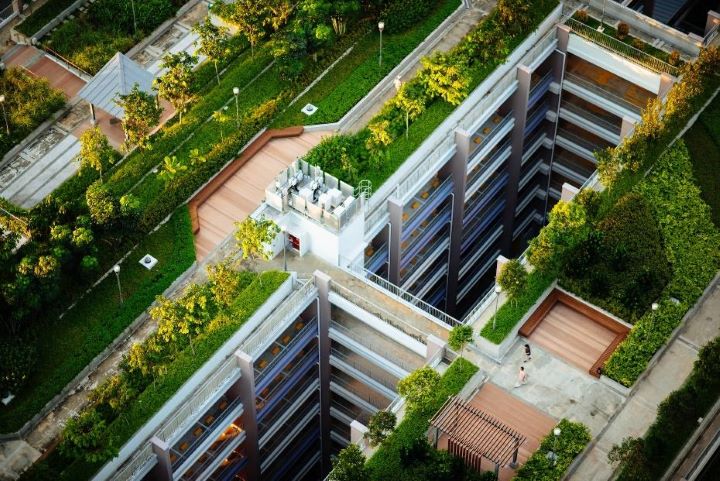If you want to make it a real estate investor, it is important to know what trends dominate the market! So, let’s take a closer look at the top commercial real estate trends in 2023.
Rise of hybrid workspaces
The rise of hybrid workspaces has transformed the way we view office setups. Many employees now enjoy the flexibility of splitting their work between home and office. So, conveniences for working from home, such as a cozy home office, can become an excellent part of an open house promotion strategy. These hybrid arrangements capitalize on the benefits of in-person collaboration and the comfort of remote work. After all, employees can avoid long commutes and gain more control over their schedules.
Moreover, employers are recognizing this shift and redesigning office spaces to be more adaptable and collaborative. As a result, businesses can enhance productivity while ensuring employee satisfaction. And in turn, a new approach to rental office setup is required. This trend is not just a response to the pandemic but a strategic move towards a more balanced and efficient work environment!

Sustainable real estate practices
Sustainable real estate practices are becoming paramount among the top commercial real estate trends. So, green building certifications and eco-friendly initiatives are gaining traction. Moreover, investors recognize that sustainability isn’t just a moral obligation but a wise financial choice. Especially since incorporating energy-efficient technologies, such as solar panels and smart HVAC systems, reduces operational costs over time. Additionally, tenants and buyers show a growing preference for eco-conscious properties. So, environmental, Social, and Governance (ESG) factors now influence investment decisions, ensuring long-term value. These practices aren’t limited to new developments since retrofitting older structures with green features is equally important. As the demand for sustainable real estate grows, the industry shifts toward a more responsible and future-oriented approach. So, the trend indicates that prioritizing the planet is aligned with financial success, making sustainable real estate a win-win strategy.

Technology integration in property management
The impact of tech on real estate is strikingly evident in property management practices. The integration of technology has revolutionized how properties are maintained and operated! IoT devices, AI-driven solutions, and data analytics streamline tasks, from predictive maintenance to tenant communication. So this leads to improved efficiency, reduced costs, and enhanced tenant experiences. Moreover, automation minimizes human error and accelerates routine tasks, such as maintenance requests and rent collection.
Additionally, technology enables remote monitoring and control, giving property managers real-time insights into building performance. So, the adoption of technology not only optimizes operations but also attracts tech-savvy tenants seeking modern amenities and convenience. As the industry evolves, property management’s reliance on technology continues to grow, giving rise to one of the most widespread top commercial real estate trends.
Logistics and industrial real estate boom
The current logistics and industrial real estate boom is undeniable, largely driven by the rapid growth of e-commerce. Warehouses and distribution centers are in high demand to meet the increasing need for efficient order fulfillment and last-mile delivery. As such, commercial storage ideas and solutions are more valuable than ever in the world of real estate! The rise of online shopping has also reshaped supply chains, prompting retailers to reevaluate their storage and distribution strategies. So, investors recognize the potential of these properties as essential components of the evolving retail landscape. Moreover, modern industrial spaces are designed to accommodate advanced automation and technology, making them a crucial asset for companies aiming to streamline operations and meet customer demands promptly. So, among the top commercial real estate trends, this one underscores the pivotal role of logistics and industrial real estate in shaping the future of retail and commerce.
Adaptive reuse and repurposing projects
Adaptive reuse and repurposing projects are gaining prominence as creative solutions for revitalizing existing structures. After all, converting obsolete buildings into functional spaces breathes new life into urban environments while preserving historical and architectural value. From repurposing factories into trendy lofts to transforming old schools into vibrant community centers, these projects offer sustainable alternatives to demolition. The appeal extends beyond aesthetics since adaptive reuse projects often reduce construction waste and contribute to more efficient land use. As urban spaces become denser, the ability to transform and adapt existing structures becomes crucial for sustainable growth! Moreover, repurposed spaces often foster unique cultural hubs that attract businesses and residents alike, contributing to the economic vitality of the surrounding area. The trend toward adaptive reuse is a testament to the importance of creativity and sustainability in shaping modern urban landscapes.
Influence of demographics on multifamily housing
The influence of demographics on multifamily housing is profound and dynamic. Different generations have diverse housing preferences, driving the evolution of apartment designs and amenities. Young professionals seek proximity to urban centers and flexible lease terms. Families desire spacious units with access to good schools and recreational areas. Empty nesters lean towards downsizing and low-maintenance living options. And urbanization and migration patterns also shape multifamily development, with certain areas experiencing increased demand due to population shifts. As a result, developers are focusing on creating versatile multifamily properties that cater to a wide range of needs. This alignment between housing and demographics ensures a steady demand for well-designed, community-centric multifamily housing units that accommodate the evolving lifestyle preferences of various age groups.

Rise of secondary and tertiary markets
The rise of secondary and tertiary markets presents new opportunities to succeed in your real estate endeavors. As primary markets become saturated and competitive, investors are turning their attention to smaller cities and towns. These emerging markets offer potential for growth, lower entry costs, and attractive rental yields. And the favorable demographics, infrastructure improvements, and lifestyle factors contribute to the appeal of these areas. Of course, investing in secondary and tertiary markets requires thorough research and an understanding of local trends, regulations, and economic indicators. Still, while there are risks involved, strategic investments can yield substantial rewards. So, as you consider expanding your real estate portfolio, exploring these markets could provide a unique avenue for long-term success. Diversifying your investments across different markets can help mitigate risks and position you for sustainable growth!
The emergence of real estate co-investing
The emergence of real estate co-investing marks a shift in investment strategies. Co-investing platforms enable individuals to pool resources and invest in larger properties collectively. So, this approach provides access to premium properties that may have been out of reach individually. Moreover, co-investing spreads risk and allows for easy portfolio diversification. However, understanding partnership agreements and due diligence is vital.
Working to leverage the top commercial real estate trends in 2023
With our guide on the top commercial real estate trends in 2023, you should have a better understanding of how you want to invest! So, strike while you can, and take advantage of some of these newly rising opportunities.


Pingback: The Benefits of Buying Real Estate for Long-Term Gain - KeyGroup - Dan & Nicole Ward, eXp Realty